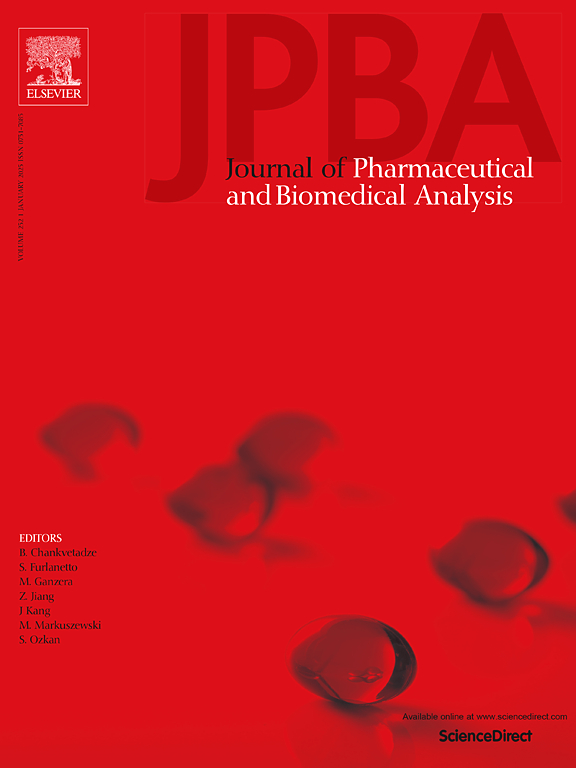Functional metabolomics revealed pyroglutamic acid may play a key role in idiopathic pulmonary fibrosis
IF 3.1
3区 医学
Q2 CHEMISTRY, ANALYTICAL
Journal of pharmaceutical and biomedical analysis
Pub Date : 2025-05-14
DOI:10.1016/j.jpba.2025.116967
引用次数: 0
Abstract
Idiopathic pulmonary fibrosis (IPF) is a chronic, progressive, and irreversible respiratory disease with poor survival rates. Despite significant research efforts, IPF still lacks a curative treatment. Excessive epithelial-mesenchymal transition (EMT) contributes to approximately one-third of fibroblasts in pulmonary fibrosis and plays a critical role in IPF pathogenesis. Identifying factors that regulate EMT is essential for developing effective therapeutic strategies for IPF. In this study, functional metabolomics revealed significant alterations in multiple metabolites in transforming growth factor-beta 1 (TGF-β1)-induced A549 cells, with pyroglutamic acid and 5-oxoprolinase (OPLAH) being identified as the most critical factors. Cellular experiments demonstrated that pyroglutamic acid effectively inhibited TGF-β1-induced EMT in A549 cells. Mechanistically, pyroglutamic acid inhibited IPF by suppressing EMT through the inhibition of Smad2/3 expression in TGF-β1-induced A549 cells. Bioinformatics analysis further elucidated the pyroglutamate is a potential metabolite that inhibits EMT. In addition, this study is the first to highlight the pivotal role of pyroglutamic acid and OPLAH in regulating EMT in IPF, offering novel insights into the metabolic mechanisms involved in IPF inhibition and providing a foundation for developing innovative therapeutic approaches for IPF.
功能代谢组学显示焦谷氨酸可能在特发性肺纤维化中起关键作用
特发性肺纤维化(IPF)是一种慢性、进行性、不可逆的呼吸系统疾病,生存率低。尽管进行了大量的研究,但IPF仍然缺乏治疗方法。过度的上皮-间质转化(EMT)在肺纤维化中约占成纤维细胞的三分之一,并在IPF发病机制中起关键作用。确定调节EMT的因素对于制定有效的IPF治疗策略至关重要。在本研究中,功能代谢组学揭示了转化生长因子-β1 (TGF-β1)诱导的A549细胞中多种代谢物的显著改变,其中焦谷氨酸和5-氧脯氨酸酶(OPLAH)被确定为最关键的因素。细胞实验表明,焦谷氨酸能有效抑制TGF-β1诱导的A549细胞EMT。在机制上,焦谷氨酸通过抑制Smad2/3在TGF-β1诱导的A549细胞中的表达来抑制EMT,从而抑制IPF。生物信息学分析进一步阐明焦谷氨酸盐是抑制EMT的潜在代谢物。此外,本研究首次强调了焦谷氨酸和OPLAH在IPF中调控EMT的关键作用,为IPF抑制的代谢机制提供了新的见解,并为开发创新的IPF治疗方法提供了基础。
本文章由计算机程序翻译,如有差异,请以英文原文为准。
求助全文
约1分钟内获得全文
求助全文
来源期刊
CiteScore
6.70
自引率
5.90%
发文量
588
审稿时长
37 days
期刊介绍:
This journal is an international medium directed towards the needs of academic, clinical, government and industrial analysis by publishing original research reports and critical reviews on pharmaceutical and biomedical analysis. It covers the interdisciplinary aspects of analysis in the pharmaceutical, biomedical and clinical sciences, including developments in analytical methodology, instrumentation, computation and interpretation. Submissions on novel applications focusing on drug purity and stability studies, pharmacokinetics, therapeutic monitoring, metabolic profiling; drug-related aspects of analytical biochemistry and forensic toxicology; quality assurance in the pharmaceutical industry are also welcome.
Studies from areas of well established and poorly selective methods, such as UV-VIS spectrophotometry (including derivative and multi-wavelength measurements), basic electroanalytical (potentiometric, polarographic and voltammetric) methods, fluorimetry, flow-injection analysis, etc. are accepted for publication in exceptional cases only, if a unique and substantial advantage over presently known systems is demonstrated. The same applies to the assay of simple drug formulations by any kind of methods and the determination of drugs in biological samples based merely on spiked samples. Drug purity/stability studies should contain information on the structure elucidation of the impurities/degradants.

 求助内容:
求助内容: 应助结果提醒方式:
应助结果提醒方式:


